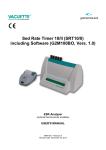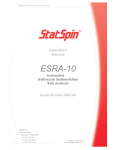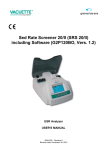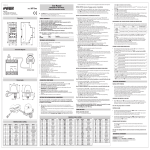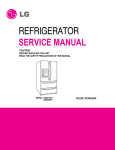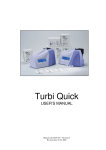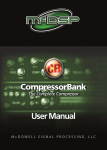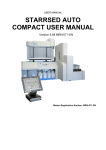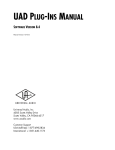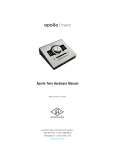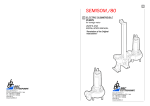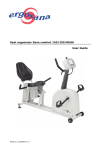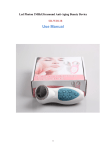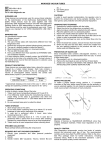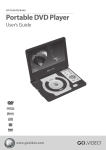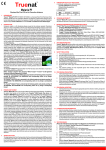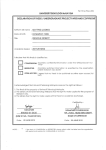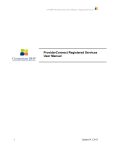Download Microsed System - star lab company
Transcript
Microsed System USER’S MANUAL Manual code MAN-074 – Revision 8 Revision date: August 26, 2010 This user manual follows the directions prescribed by UNI EN 591:2001 (Instructions for use for in vitro diagnostic instruments for professional use) INSTRUMENT NAME: MICROSED-SYSTEM ESR Automated Analyzer 10 measuring channels. INSTRUMENT MANUFACTURER: VITAL DIAGNOSTICS s.r.l. Via Balzella, 41/G/4 47122 FORLI - ITALY phone: + 39 (0543) 72 12 20 fax: + 39 (0543) 79 60 01 INSTRUMENT DISTRIBUTOR: MICROSED – USER'S MANUAL Vital Diagnostics CONTENTS Page 1 INTENDED USE ................................................................................................................................................ 6 2 IMPROPER USE ............................................................................................................................................... 6 3 SYSTEM DESCRIPTION ................................................................................................................................ 6 3.1 3.2 3.3 3.4 3.5 3.6 3.1 3.2 3.3 4 ANALYZER UNIT .......................................................................................................................................... 6 POWER SUPPLY ......................................................................................................................................... 6 DISPLAY ..................................................................................................................................................... 6 READING PLATE ......................................................................................................................................... 6 BAR CODE READER (OPTIONAL) ............................................................................................................... 7 PRINTER (OPTIONAL) ................................................................................................................................. 7 TEST TUBES ............................................................................................................................................... 7 TUBES HANDLING REQUIREMENTS ............................................................................................................ 7 TUBES STORAGE REQUIREMENTS ............................................................................................................. 7 POTENTIAL DANGERS, SAFETY MEASURES AND DISPOSAL ......................................................... 8 4.1 4.2 4.3 4.4 4.5 4.6 4.7 5 USER PRECAUTIONS .................................................................................................................................. 8 ELECTRICAL EQUIPMENT ........................................................................................................................... 8 MECHANICAL EQUIPMENT .......................................................................................................................... 8 SAMPLES .................................................................................................................................................... 8 NOTES ON SAFETY MEASURES .................................................................................................................. 8 RESIDUAL RISKS ........................................................................................................................................ 9 DISPOSAL AND RECYCLING ....................................................................................................................... 9 INSTALLATION ............................................................................................................................................... 10 5.1 5.2 6 POSITIONING OF THE ANALYZER .............................................................................................................. 10 INSTRUMENT STARTUP ............................................................................................................................ 10 OPERATING PROCEDURE ......................................................................................................................... 11 6.1 6.2 6.3 6.4 6.5 6.6 6.7 6.8 6.9 6.10 6.11 7 SAMPLE’S COLLECTION ............................................................................................................................ 11 TUBES LABELING ..................................................................................................................................... 11 SAMPLE MIXING ........................................................................................................................................ 11 SAMPLE INSERTION .................................................................................................................................. 11 SAMPLE IDENTIFICATION .......................................................................................................................... 12 REMAINING TIME ...................................................................................................................................... 12 RESULTS PRE-INDICATION....................................................................................................................... 12 SAMPLE REMOVAL .................................................................................................................................... 13 INTERNAL QUALITY CONTROL .................................................................................................................. 13 INSTRUMENT CALIBRATION ...................................................................................................................... 13 TEMPERATURE CORRECTION .................................................................................................................. 13 ERROR AND WARNINGS ............................................................................................................................ 14 7.1 7.2 7.3 8 W ARNINGS INFORMATION ........................................................................................................................ 14 SYSTEM ERROR W ARNINGS .................................................................................................................... 14 SERVICE ................................................................................................................................................... 14 MAINTENANCE .............................................................................................................................................. 14 8.1 8.2 CLEANING INSTRUCTIONS ........................................................................................................................ 14 TROUBLE-SHOOTING GUIDE .................................................................................................................... 15 APPENDIX................................................................................................................................................................. 16 A. THEORETICAL INFORMATION .............................................................................................................. 16 A.1 Westergren Method ................................................................................................................................ 16 A.2 Normal ESR values according to Westergren ..................................................................................... 16 A.3 Variation of ESR ...................................................................................................................................... 16 Pag 4/21 MICROSED – USER'S MANUAL Vital Diagnostics A.4 Bybliography ............................................................................................................................................ 17 PERFORMANCE CRITERIA AND LIMITATIONS ................................................................................. 17 B.1 Performance Criteria ................................................................................................................................ 17 B.2 Limitations ................................................................................................................................................. 17 C. DIP-SWITCH CONFIGURATION............................................................................................................. 18 D. RS232 CONNECTOR DESCRIPTION AND I/O DATA FORMAT ....................................................... 19 E. TECHNICAL SPECIFICATIONS .............................................................................................................. 20 F. EC DECLARATION .................................................................................................................................... 21 B. Pag 5/21 Vital Diagnostics 1 MICROSED – USER'S MANUAL INTENDED USE The MICROSED-SYSTEM ESR analyzer is an automatic instrument for the analysis of the erythrocyte sedimentation rate. It constantly and simultaneously scans 10 test tubes which are custom-made for ESR analysis. 2 IMPROPER USE Following uses are considered improper: 1) Use of the device to obtain results different from ESR 2) Use tubes different from those specified in this manual 3) Every attempt to open tubes analyzed by the device 4) Use the device to analyze samples different form those specified The above mentioned uses and every attempt to use the MICROSED-SYSTEM ESR analyzer with a purpose different from the intended use, must be considered improper. 3 SYSTEM DESCRIPTION 3.1 Analyzer unit The MICROSED-SYSTEM ESR analyzer is an automatic instrument exclusively employed for analysis of the erythrocyte sedimentation rate. Its total absence of commands, its precision and its ability to obtain the result already corrected to a temperature of 18°C (according to Manley) in only 15 or 30 minutes, make the Microsed-System ESR the most innovative and versatile system for this kind of analysis. It constantly and simultaneously scans 10 test tubes which are custom-made for ESR with this system. MICROSED-SYSTEM follows the sedimentation of each sample independently, memorizing levels for the whole period of analysis. This allows the instrument to be used for random loading of the samples and for a continuous loading up to a capacity of 10 test tubes at a time. When the first sample is analyzed, it can be replaced by another one, so it is possible to achieve up to 40 tests / h. MICROSED-SYSTEM has been conceived to simplify ESR analysis as much as possible, avoiding sample manipulation and operator’s infection risk. To perform the analysis, the operator must simply place the sample test tube directly into the instrument. The result appears on the display in only 15 or 30 minutes. When the compensation of the result is active, the MICROSED-SYSTEM surveys the room temperature and converts the result to the reference temperature of 18°C. (Manley). This is necessary in order to avoid considerable variations of values due to different room temperatures. 3.2 Power Supply The analyzer is provided with an external power supply with low voltage output. The power supply comes along with the analyzer. 3.3 Display An LCD display with back-lighting, allows constant monitoring of the analyses and visualization of the results. Sample or system error messages may also be displayed. 3.4 Reading Plate One row of 10 test tube positioning channels, numbered from 1 to 10. Pag 6/21 MICROSED – USER'S MANUAL 3.5 Vital Diagnostics Bar Code Reader (optional) An external barcode reader can be connected to the instrument with a special cable. The cable can be requested with the code: EEE30-099 – “Cable MSS10C04 printer, barcode” The barcode reader must be an RS232 port standard model, with its own power supply unit. The barcode scanner configuration must be set with the following serial port setting: - 9600 bps, 8 data bits, no parity, 1 stop bit, no handshake control signals. 3.6 Printer (optional) Can be connected to the instrument, it prints out ESR results and sedimentation graph, according to the loading sequence, whenever an analysis is completed. It is external so it can be easily replaced. Printer Technical Data: Type DPT-100 Power supply input printing type columns conformity 3.1 Direct powered from Microsed serial RS 232 thermal 24 CE Test Tubes The unique test tubes that can be used with this instrument are Monosed Vacuum Tube expressly made to be used with the MICROSED-SYSTEM. They contain sodium citrate at 3,8% and have a fixed vacuum to draw blood (item PRD-PRV-GE011-B / PRD-PRV-GE011-V for high altitude). 3.2 Tubes Handling requirements The vacuum test tube needs to be inserted properly into its holder to obtain the automatic draw of blood required for the analysis. Tubes are removed from the holder only after the draw has been terminated completely, i.e. the required amount of blood for the analysis has been properly evacuated. If an incorrect blood collection occurs, MICROSED SYSTEM will refuse to analyze the sample, indicating “lev” (level) error, because the Sedimentation Rate would be incorrect, due to an erroneous ratio with the anticoagulant present in the tube. All vacuum test tubes need to be mixed gently immediately after blood collection, to ensure a proper mixing of the sodium citrate with the freshly drawn blood. Therefore, tubes are gently turned completely upside down five times, ensuring that the air-bubble floats correctly from one end of the tube to the other. ESR tests should be carried out no later than 3-4 hours after blood collection, if samples are kept at room temperature: Refer to Tubes instructions to perform this operation correctly. 3.3 Tubes storage requirements Store the test tubes at room temperature, always below 30°C .Never place the bench top tube container near a heating device or a window where direct sunlight could create an unwanted heating effect. Pag 7/21 Vital Diagnostics 4 4.1 MICROSED – USER'S MANUAL POTENTIAL DANGERS, SAFETY MEASURES AND DISPOSAL User Precautions Before beginning work with the analyzer, the operator, to protect himself from any danger, must know the rules for handling potentially infectious materials and for the Electro-mechanical systems. 4.2 Electrical Equipment As in all electrical equipment the power supply is a potential source of danger. For this reason, avoid handling parts directly hooked up to the supply without disconnecting them. Never carry out maintenance on the equipment when it is under electrical tension. Until the equipment remains closed as supplied, the operator is protected against electric shock. The parts to pay attention to are: the power supply and the printer. The MICROSED-SYSTEM analyzer, being powered by low voltage, doesn’t present the same dangers of the equipment’s powered by an electrical line. MICROSED-SYSTEM analyzer has inside a voltage elevator circuit, so it can provoke strong electrical shocks, but it is not dangerous for the personnel dedicated to the service assistance. In any case, we suggest disconnecting the power supply when the operator intervenes on the instrument’s internal parts. 4.3 Mechanical equipment Even for the mechanical part of the analyzer, we suggest you not to open the machine before having disconnected it from the power supply. It presents only one handling that it is not dangerous for the operator, but it would damage if brought into contact with the parts in movement. 4.4 Samples All the biological fluids must be considered potentially infectious by operators. Even if for the execution of the analysis the blood is not handled (because the operator must not remove the tube stopper), the operator has to adopt the national and international standards of precautions to avoid the biological danger. The same rules must be adopted by the technical-qualified assistance operator when intervenes on this instrument. 4.5 Notes on safety measures The operator must pay a special attention to the sample collection. Must use the correct vacuum test tubes described for this equipment in this manual, since these tubes have been studied to aspirate the right level of blood. Every attempt to put the blood into test tubes different to the one described, brings serious dangers of infection due to the risk of sample coming out, and this, moreover, will damage the optical part inside the instrument and provoke the loss of the guarantee. Refer to the tubes manual to have more detailed. On the instrument, to assure a correct use of the instrument, may be placed the following symbols: Attention: read use instruction For in vitro diagnostic use only ELECTROSTATIC DISCHARGE SENSITIVE DEVICE (ESDS): The device could be damaged by electrostatic potentials Pag 8/21 MICROSED – USER'S MANUAL 4.6 Vital Diagnostics Residual Risks Despite of the measures taken in the designing of the machine to guarantee a safe use of it, there might happen reasonably predictable occurrences, whose risk was possible to reduce, but not to eliminate completely. 4.7 RESIDUAL RISKS PROTECTION MEASURES Biological contamination The operator must wear always gloves and protection glasses, as prescribed by laboratory regulations. Do not ever open tubes Tubes breaking Insert and remove tubes from holes maintaining a vertical position, without applying lateral forces. Disposal and Recycling Herewith we declare that this instrument is subject to the European Directive 2002/96/EC (RAEE Directive). Therefore the instrument must be disposed separately, not as urban waste and delivered to the specific collection center in according to the Directive 2002/96/EC. The user can ask to the dealer the collection of the instrument if a new instrument is ordered to replace the old one. On the instrument there is a label with the symbol shown in this page. The symbol means that the instrument can not be disposed as urban waste. Pag 9/21 Vital Diagnostics MICROSED – USER'S MANUAL 5 INSTALLATION 5.1 Positioning of the analyzer The MICROSED-SYSTEM must not be placed near centrifuges, oscillating agitators or other vibrating instruments which might cause movement of the bench. Please, keep in mind that the ESR is very sensitive to vibrations that could cause a false increase of results. The bench must be flat and level. Direct light on the instrument and sudden changes of temperature should be avoided. 5.2 Instrument Startup Check the instrument configuration for your needs, see appendix for switches information. Connect power supply outlet to the instrument. Insert the power supply plug in a socket with an earth connection. If the instrument has an optional printer and/or a bar code scanner, they should be connected to the MICROSED-SYSTEM with the appropriate cable and plugged in. Connect and switch-on first the printer, then the MICROSED-SYSTEM using the switch situated at the rear side of the instrument. Each time it is switched on, MICROSED-SYSTEM carries out an electronic initialization and an instrument self test. The following messages will appear: Self Test Start... During the self test, the instrument checks electronics parts and which kind of configuration is set. The following messages will appear: This message inform the user about the printer status and if the sedimentation is active or not. If the printer is not connected to the device, this message will appear. This message informs the user on the reading time and on how results will be displayed and/or printed out. This message informs the user on the temperature correction status and on the temperature measured by the instrument. Once the Self test is finished, the following message will appear: Self Test Ok... Pag 10/21 MICROSED – USER'S MANUAL Vital Diagnostics Now the instrument is ready for the analysis. The result type and temperature are shown always in the display. In the bottom line of the display there are results values. The following screen is an example: 6 OPERATING PROCEDURE 6.1 Sample’s collection Samples must be collected following the vacuum technique, using only the right tube previously defined. During sample collection, wait until the test tube vacuum has completed the drawing of the blood in order to be sure of having drawn the right volume. See the tube’s instructions for a correct use. Tubes Labeling Identify the sample by writing on the original test tube label or by applying a bar code label. Follow the scheme to carry out this action correctly. In the figure the test tube “A” has the correct blood level and the original label on which to write the patient code or any other relevant data if the bar code label is absent. The part marked “H” shows the transparent zone that must be absolutely free and clear to allow the infrared rays to recognize the end of the blood H column. The next test -tube “B” shows the correct position for the label. Test- tubes C and D illustrate how erroneous applications of the labels obstruct the reading of the analysis. If the MICROSED-SYSTEM Analyzer is installed in the surgery, the sample can be immediately analyzed by placing samples in a free position. Anyway the sample should be analyzed within three hours, paying attention to external agents shown below that might alter ESR in the pre-analysis phase. 6.3 B C D YES NO NO LABEL A LABEL 6.2 YES Sample mixing If it is not possible to analyze samples immediately after the collection, samples must be mixed delicately by overturning for at least five minutes. Use a rotating laboratory agitator or a dedicated mixing device. The recommended rpm-value for the mixer is 15-20 RPM. 6.4 Sample insertion After mixing, the sample must be promptly transferred to the analyzer. It is also advisable to follow numerical sequence when loading channels. Every time a sample is inserted into a free channel an acoustic signal inform the user that the instrument recognized the tube. After loading the tenth, wait for the results and then remove analyzed samples from their channels before inserting new tubes. The sample positions on the plate are numbered from 1 to 10 but numbering is intended progressively in groups of 10, so when the tube in channel one is analyzed and removed, this position automatically becomes number 11 and so on. Pag 11/21 Vital Diagnostics 6.5 MICROSED – USER'S MANUAL Sample Identification If samples are identified by a barcode label, they can be identified using an external barcode scanner. The maximum ID length readable by the instrument is 12 digits. Do not overrun this limit. To perform this procedure correctly, follow these steps: 1) 2) read the barcode label insert the tube in the first free channel within 15 seconds form reading The instrument will detect automatically the position of the new inserted tube and the ID will be automatically associated to that position. The display will show for some seconds: +----------------------------------------+ |New sample... | |Pos: 1 Pat.ID: 012345678912 | +----------------------------------------+ If a printer is connected, once the instrument finishes an analysis, the following information will be printed out: Smpl.Chan.PatID# 1 1 ............ 30' 1h 2h 3 5 11 mm ( no ID present ) Smpl.Chan.PatID# 1 1 123456789012 30' 1h 2h 3 5 11 mm ( ID: 123456789012 ) If the bar code is not available, to identify samples, write sample’s ID on the label of each sample and prepare a report where to write the sample ID and the correspondent channel of the instrument where the sample has been inserted. 6.6 Remaining time During sample analyses, on the display appears for each sample the following symbol as indication of the remaining analysis time.. time remaining symbols 6.7 Results Pre-indication Approximately 10 minutes after tubes insertion, the following symbols will appear on the display, giving a pre-indication of the results: % of Sedimentation at 10 minutes | Symbol ---------------------------------------------< 16 | -< 40 | +>= 40 | ++ This is only a pre-indication and it can’t be used as final result. Please note, pre-indication is shown only on 30 and 60 minutes reading mode. Pag.12 / 21 MICROSED – USER'S MANUAL Vital Diagnostics 6.8 Sample removal As soon as sample has been analyzed, the result will be automatically printed out if a printer is connected. Results will stay on the display until the tube removal. Remove tubes carefully, maintaining tubes in vertical position, in order to avoid tubes breaking. If the tube is removed before the end of the analysis, the instrument prints “rem” (removed) error. 6.9 Internal Quality control Good Laboratory Practices suggest to test every day at least one control (1 normal and 1 abnormal) to check if the instrument is working correctly. Vital Diagnostics developed a special control for ESR values: Precision Rate (ref.: PRD-ESRQC). This control simulates the behavior of normal and abnormal human blood and can be used to test the instrument’s performances. Controls must be tested exactly as normal patient’s samples and results should be recorded on Quality Control Charts. Each laboratory can establish its own acceptability ranges. Refer to Precision Rate instructions for more detailed information. 6.10 Instrument Calibration Each instrument is pre-calibrated by the manufacturer and it does not require a user re-calibration. The calibration of each instrument is traceable from the serial number of the instrument. 6.11 Temperature Correction The obtained results are correlated to the method of reference related to the room temperature. MICROSEDSYSTEM, constantly measuring the analysis temperature, further reconverts the values obtained to the reference one of 18 degrees using the Manley table thus ensuring better reproducibility instead of analyses performed at different temperatures. Manley table ___________________________________________________________________ 18°C. 15°C. 18°C. 20°C. 25°C. 30°C. 5 10 20 30 40 50 60 70 80 90 100 4 9 18 27 36 46 55 63 72 81 90 5 10 20 30 40 50 60 70 80 90 100 5 10 21 31 42 52 62 72 82 93 103 6 12 25 37 49 60 71 82 93 103 114 8 16 31 45 58 71 82 93 104 114 125 MICROSED-SYSTEM converts the results to 18 degrees as per the table if analysis room temperature is between 15 and 32 degrees C. For lower or higher room temperatures the instrument's conversion limits are: 15 degrees for lower temperatures and 30 degrees for higher. Pag 13/21 Vital Diagnostics 7 ERROR AND WARNINGS 7.1 Warnings Information MICROSED – USER'S MANUAL These Messages may appear on the display : LEV: Indicates that the sample level is not into the range permitted by the instrument. REM: Indicates that the test tube has been removed from the position in which it had been placed. The test tubes are checked in their positions every second. Do not touch the test tubes during the whole period of analysis because, for the reason described, the result will be lost. 7.2 System Error Warnings "MEC ERROR: system stopped..." or "ERROR: call service..." These warnings will be given if the instrument should find problems with the mechanical movement of the reading plate. After this indication the instrument will definitely stop its operation and the technical service must be called. 7.3 Service In case of malfunctioning of the instrument, service can be made only by authorized personnel. Only technicians with a certificate which states that they have followed a service training in Vital Diagnostics or made by a Vital Diagnostics authorized person, can operate service on the instruments. If a technician is not available, defective instruments can be sent to Vital Diagnostics after calling the technical service. Please contact your instrument distributor. 8 MAINTENANCE Due to component parts simplicity, MICROSED-SYSTEM does not require special maintenance. The most sensitive part is the infrared sensors inside the instrument. Pay attention to the cleanliness of reading plate: when not used, it must be covered with the dust cover supplied along with the reader. Do not clean the reading plate with liquids. The entry of liquids or solid material into channels can cause considerable damage to the instrument. 8.1 Cleaning Instructions Dust can be removed using an ordinary vacuum cleaner. It is advisable to clean once a month the instrument externally with a disinfectant solution to reduce the microbial contamination. Concerning test tubes, they must remain well closed and the cap should absolutely not be removed. The label must be correctly positioned and well stuck to the test tube surface. Label fragments could fall into the test tube and obstruct a correct reading function during analysis. Pag.14 / 21 MICROSED – USER'S MANUAL Vital Diagnostics 8.2 Trouble-Shooting guide Before calling for a service technician, please check the handling of sample collection, mixing procedures and operating instructions. ALARM OR TROUBLE LEV REM T.ERR MEC. ERROR or ERROR call service Data result is not printed Data result seems not correct CAUSE REMEDY a) sample level high or low a) repeat sample collection b) the label was not placed in its b) replace label and repeat analysis proper position. Sample has been removed repeat analysis “Temperature error” data-analysis is not converted sensor malfunction to 18 C. Call service assistance Motor or mechanical malfunction Call service assistance a) Printer power b) Printer cable c) Instrument printer configuration a) sample clot b) sample has foam c) sample measured after 4 hours from sample collection d) sample short mixing e) temperature conversion is OFF One or more samples are shown on a) paper pieces or dust on sensors the display without tubes introduced b) internal cable problem Barcode reading not work a) adapter cable problem b) scanner power problem c) wrong ID procedure No info on display a) Instrument switch problem b) Instrument power problem c) Internal problem PRINTER NOT READY..... a) Printer is not connected Message b) Printer out of paper c) Printer cable problem Analysis end delay on display Analysis end delay on printer a) Check power supply b) Check cable c) Check instrument configuration d) Replace printer a) repeat sample collection b) remix gently c) check instrument configuration a) Call service assistance a) Check adapter cable b) Check power of the scanner c) read the user manual a) Check instrument switch b) Check power supply unit c) Call service assistance a) Connect the printer or turn off printer configuration. b) load a new roll of paper b) Check the printer cable a) Printer is not connected but a) Connect the printer or turn off enabled printer configuration. b) Printer out of paper b) load a new roll of paper c) Printer cable problem c) Check the printer cable d) Random samples inserted, the d) NO PROBLEM, results are reading plate is moving always correct Random samples inserted, the NO PROBLEM, results are always reading plate is moving correct Pag 15/21 Vital Diagnostics MICROSED – USER'S MANUAL APPENDIX A. THEORETICAL INFORMATION A.1 Westergren Method This is the standard method in accordance with the Clinical and Laboratory Standard Institute (CLSI). It consists of a support that keeps the Westergren tubes, containing incoagulable blood, perfectly vertical and hermetically sealed. Westergren tubes have a diameter of 2.5 mm and are graduated up to 200 mm. As soon as the sample is taken the venous blood is mixed with a sodium citrate solution at 3.8% (0.13 M), in the ratio of respectively four to one (1.6 ml + 0.4 ml of sodium citrate). The blood thus prepared and well mixed is drawn into a Westergren tube up to the zero mark. The tube is inserted in the appropriate support and the erythrocyte level is read after 60 min. A.2 Normal ESR values according to Westergren Mean ESR Age (Yrs.) Male Female 18-30 31-40 41-50 51-60 60 - 70 Over 70 3.1 3.4 4.6 5.6 5.6 5.6 5.1 5.6 6.2 9.4 9.4 10.1 Upper Limit of Normal Male Female <7.1 <10.7 <7.8 <11.0 <10.6 <13.2 <12.2 <18.6 <12.7 <20.2 <25.1 <25.1 A.3 Variation of ESR Net increase of ESR (100 mm or more per hour) 1. Multiple myeloma and Waldenstrom macroglobulinemia 2. Malignant lymphoma 3. Leukaemia 4. Serious anaemia 5. Carcinomas 6. Sarcomas 7. Serious bacterial infections 8. Collagenosis 9. Biliary or portal cirrhosis 10. Ulcerous colitis 11. Serious nephrosis Moderate increase of ESR 1. Acute and chronic contagious diseases 2. Acute localised infections 3. Reactivation of a chronic infection 4. Rheumatic illness 5. Rheumatoid arthritis 6. Myocardial infarction 7. Malignant tumour with necrosis 8. Hyperthyroidism 9. Hypothyroidism 10. Lead or arsenic poisoning 11. Nephrosis 12. Internal haemorrhage Pag.16 / 21 15. Broken ectopic pregnancy 16. Menstruation 17. Normal pregnancy after the third month 18. Oral contraceptives taken 19. Tuberculosis 20. Postcommissurotomy syndrome 21. Dextran administered intravenously Normality of ESR (most cases) 1. First stage acute appendicitis (in the first 24 hours) 2. Precocious integral ectopic pregnancy 3. Malarial paroxysm 4. Cirrhosis of the liver 5. Arthrosis 6. Mononucleosis 7. Acute allergies 8. Viruses without complications 9. Peptic ulcer 10.Typhoid fever 11.Undulant fever MICROSED – USER'S MANUAL Vital Diagnostics 13. Acute hepatitis 14. Ectopic pregnancy unbroken after the third month 12. Rheumatic carditis with cardiac decompensation 13. Whooping cough Variation of the ESR due to External agents (once blood is in the tube) a) dilution ratio, b) bubbles c) strongly haemolytic samples d) sudden agitation e) temperature f ) time after sample collection g) direct sunlight h) foam i ) lipemic samples A.4 Bybliography 1) THYGESEN, J.E.(1942). The mechanism of blood sedimentation. Acta Medica Scandinavia, Suppl. 134. 2) WINTROBE,M.M. and Landsberg, J.W. (1935). A standardised technique for the blood sedimentation test. American Journal of Medical Sciences, 189, 102 3) HARDWICKE, J. and SQUIRE, J.R. (1965). The basis of the erythrocyte sedimentation rate. Clinical Science, 11, 333 4) International Committee for Standardisation in Haematology (1977). Recommendation for measurement of erythrocyte sedimentation rate of human blood. American Journal of Clinical Pathology, 68,505 5) LASCARI, A.D. (1972). The erythrocyte sedimentation rate. Paediatric Clinics of North America, 19,1113 6) MANLEY, R.W. (1957). The effect of room temperature on erythrocyte sedimentation rate and its corrections. Journal of Clinical Pathology, 10, 354 B. PERFORMANCE CRITERIA AND LIMITATIONS B.1 Performance Criteria A. Mechanical/ Optical precision of detection: +/- 0.2 mm B. Reproducibility of analysis: C.V. < 5 % (for samples with a ESR > 40 mm/h) C. Automatic temperature conversion to 18°C. ( Manley table ): Accepted range: Range 15° - 32° C. D. Level range for correct analysis: from 50 to 60 mm from the bottom of the tube (correspondent to the 2 rings painted on the tube) F. Measuring range: 1 - 140 mm/h G. Results pre-indication : after about 10 minutes B.2 Limitations A. Strongly lipemic or haemolytic samples may alter reading capability. B. Sed rate values > 140 mm/h will be indicated with this mark only. C. Temperatures outside the given range will be accepted as 15 ° min and 32° max Pag 17/21 Vital Diagnostics C. 12345678- MICROSED – USER'S MANUAL DIP-SWITCH CONFIGURATION enable results mm/30 minutes Westergren Working time selection ( Off = 30’ ; ON= 30/60’). Results 1/h or 1/h and 2/h Westergren enable temperature compensation at 18°C (switched ON as default) printer output enable (note: turn off this switch if no printer is connected) enable sedimentation graphic printout enable 15’ of working time with results mm/h Westergren only internal fan enable (switched ON as default) enable DC power supply for external DPT100 thermal printer NOTE: the function is active if the dip switch is on “ON” position. DIP SWITCH CONFIGURATION EXAMPLES Pag.18 / 21 MICROSED – USER'S MANUAL Vital Diagnostics D. RS232 CONNECTOR DESCRIPTION AND I/O DATA FORMAT NOTE: Data format is: 9600 bps, 8 data bit, 1 stop bit, no parity, hardware protocol RTS-CTS for printer, no protocol for barcode scanner. Instrument 9 pin female connector: PIN DIRECTION NAME DESCRIPTION ---------------------------------------------------------------1 ----(Do not connect!) 2 INPUT RXD Barcode data input 3 OUTPUT TXD Printer / Host data output 4 OUTPUT DTR Data Terminal Ready 5 --GND Ground 6 ----(Do not connect!) 7 OUTPUT +12 Power supply for external custom printer 8 INPUT CTS Clear to send 9 ----(Do not connect!) DIRECT HOST CONNECTION CABLE EXAMPLE ---------------------------------------------------------------------Note: The connectors of the cable are 9 pin. Male (instrument) 2 3 4 8 5 Female (to host) ------------------------------------------------------------- 3 2 8 4 5 HOST, PRINTER AND BARCODE CONNECTION CABLE EXAMPLE ---------------------------------------------------------------------Note: The connectors of the cable are 9 pin. The printer must be connected and ready to print. Male ( instrument ) 2 3 8 5 7 +--------| +------| | | | ---+ | -----+-o---------+-+---------o-+---------+-+----| | | | | +----+------- 2 5 Male ( barcode reader ) 3 8 5 7 Female ( printer ) 3 5 Male ( host ) Pag 19/21 Vital Diagnostics E. MICROSED – USER'S MANUAL TECHNICAL SPECIFICATIONS Area of application: Blood sedimentation rate analysis Instrument size: Weight: Height 140 mm, Width 180 mm, Depth 100 mm about 0.9 kg Instrument input power: External power supply unit input power: 12 Vdc 1.5 A (external power supply unit) 100 - 240 Vac 50/60 Hz Operating Conditions: temperature 15° - 32° C room temperature humidity: 45% - 85% not condensed Reading channels: Reading time (selectable): Analytical capacity: Loading pattern: 10 15, 30 or 60 minutes max 40 tests/h random Blood draw level acceptance from normal from 50 to 60 mm from the bottom of the tube (correspondent to the 2 rings painted on the tube) Measuring method: Reading resolution: Results resolution: IR beam +/- 0,2 mm +/- 1 mm Temperature correction: automatic compensation referred to 18°(Manley) Results (selectable): in Westergren mm/30’, mm/1h, mm/2h. Interface: Single RS 232 port for printer output and barcode scanner input Pag.20 / 21 MICROSED – USER'S MANUAL Vital Diagnostics F. EC DECLARATION DICHIARAZIONE DI CONFORMITÁ CE EC DECLARATION OF CONFORMITY conforme all’Allegato III della Direttiva 98/79/CE Dispositivi Medico-Diagnostici In Vitro conforme all’Allegato II della Direttiva 2006/42/CE Direttiva Macchine according to Annex III of the Directive 98/79/CE In Vitro Diagnostic Medical Devices according to Annex II of the Directive 2006/42/CE fabbricante manufacturer Vital Diagnostics S.r.l. Via Balzella 41/G/4 indirizzo address 47122 FORLI’ telefono 0039 0543 721220 phone Identificazione dei prodotti Product identification ITALIA fax 0039 0543 796001 fax Analizzatore Automatico della VES ESR Automated Analyzer Nome commerciale Brand name MICROSED-System Numero/i di catalogo Part number/s classificazione dei prodotti product identification PRD-MSS dispositivi diversi da quelli elencati nell’Allegato II della Direttiva 98/79/CE devices other than those mentioned in Annex II of the Directive 98/79/EC norme applicabili applicable standards General Directives: n.: 98/79/EC n.: 2002/95/EC n.: 2003/108/EC EMC Standards: n.: EN 61326-6:2006 Safety Standards: n.: EN 61010-1:2001 n.: EN 61010-2-101:2002 Machine Directives: n.: 98/37/EC n.: 98/79/EC n.: 2006/42/EC Si dichiara sotto la propria responsabilità che i dispositivi sopraelencati rispettano le disposizioni applicabili delle normative di cui sopra. Tutta la documentazione tecnica richiesta dalle suddette normative è conservata a cura del Fabbricante. Hereby we declare under our sole responsibility that the above mentioned devices meet the applicable provisions of the directives written above. All the supporting documents are retained under the premises of the Manufacturer. luogo e data place and date Forlì, 19/02/2010 anno di immissione in commercio year of introduction on the market 1997 firma signature Pag 21/21





















